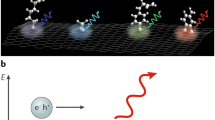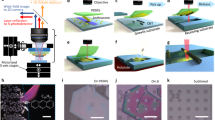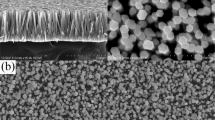Abstract
Carbon nanotubes1,2 are a good realization of one-dimensional crystals where basic science and potential nanodevice applications merge3. Defects are known to modify the electrical resistance of carbon nanotubes4; they can be present in as-grown carbon nanotubes, but controlling their density externally opens a path towards the tuning of the electronic characteristics of the nanotube. In this work, consecutive Ar+ irradiation doses are applied to single-walled nanotubes (SWNTs) producing a uniform density of defects. After each dose, the room-temperature resistance versus SWNT length (R(L)) along the nanotube is measured. Our data show an exponential dependence of R(L) indicating that the system is within the strong Anderson localization regime. Theoretical simulations demonstrate that mainly di-vacancies contribute to the resistance increase induced by irradiation, and that just a 0.03% of di-vacancies produces an increase of three orders of magnitude in the resistance of a SWNT of 400 nm length.
This is a preview of subscription content, access via your institution
Access options
Subscribe to this journal
Receive 12 print issues and online access
$259.00 per year
only $21.58 per issue
Buy this article
- Purchase on Springer Link
- Instant access to full article PDF
Prices may be subject to local taxes which are calculated during checkout




Similar content being viewed by others
References
Iijima, S. Helical microtubules of graphitic carbon. Nature 354, 56–58 (1991).
Ajayan, P. M. & Ebbesen, T. W. Nanometre-size tubes of carbon. Rep. Prog. Phys. 60, 1025–1062 (1997).
Baughman, R. H., Zakhidov, A. A. & de Heer, W. A. Carbon nanotubes — the route toward applications. Science 297, 787–792 (2002).
Bockrath, M. et al. Resonant electron scattering by defects in single-walled carbon nanotubes. Science 291, 283–285 (2001).
Packan, P. A. Device physics: Pushing the limits. Science 285, 2079–2081 (1999).
Bachtold, A., Hadley, P., Nakanishi, T. & Dekker, C. Logic circuits with carbon nanotube transistors. Science 294, 1317–1320 (2001).
Hashimoto, A., Suenaga, K., Gloter, A., Urita, K. & Iijima, S. Direct evidence for atomic defects in graphene layers. Nature 430, 870–873 (2004).
Javey, A., Guo, J., Wang, Q., Lundstrom, M. & Dai, H. J. Ballistic carbon nanotube field-effect transistors. Nature 424, 654–657 (2003).
Park, J. Y. et al. Electron-phonon scattering in metallic single-walled carbon nanotubes. Nano Lett. 4, 517–520 (2004).
Datta, S. Electronic Transport in Mesoscopic Systems (Cambridge Univ. Press, Cambridge, 1997).
Pascual, J. I. et al. Properties of metallic nanowires — from conductance quantization to localization. Science 267, 1793–1795 (1995).
Javey, A. et al. High-field quasiballistic transport in short carbon nanotubes. Phys. Rev. Lett. 92, 106804 (2004).
Bachtold, A. et al. Aharonov-Bohm oscillations in carbon nanotubes. Nature 397, 673–675 (1999).
Terrones, M. et al. Molecular junctions by joining single-walled carbon nanotubes. Phys. Rev. Lett. 89, 075505 (2002).
Kis, A. et al. Reinforcement of single-walled carbon nanotube bundles by intertube bridging. Nature Mater. 3, 153–157 (2004).
Choi, H. J., Ihm, J., Louie, S. G. & Cohen, M. L. Defects, quasibound states, and quantum conductance in metallic carbon nanotubes. Phys. Rev. Lett. 84, 2917–2920 (2000).
Crespi, V. H., Cohen, M. L. & Rubio, A. In situ band gap engineering of carbon nanotubes. Phys. Rev. Lett. 79, 2093–2096 (1997).
Anantram, M. P. & Govindan, T. R. Conductance of carbon nanotubes with disorder: A numerical study. Phys. Rev. B 58, 4882–4887 (1998).
McEuen, P. L., Bockrath, M., Cobden, D. H., Yoon, Y. G. & Louie, S. G. Disorder, pseudospins, and backscattering in carbon nanotubes. Phys. Rev. Lett. 83, 5098–5101 (1999).
Stahl, H., Appenzeller, J., Martel, R., Avouris, P. & Lengeler, B. Intertube coupling in ropes of single-wall carbon nanotubes. Phys. Rev. Lett. 85, 5186–5189 (2000).
de Pablo, P. J. et al. Nonlinear resistance versus length in single-walled carbon nanotubes. Phys. Rev. Lett. 88, 36804–36808 (2002).
Gomez-Navarro, C., de Pablo, P. J. & Gomez-Herrero, J. Radial electromechanical properties of carbon nanotubes. Adv. Mater. 16, 549–552 (2004).
Krasheninnikov, A. V., Nordlund, K., Sirvio, M., Salonen, E. & Keinonen, J. Formation of ion-irradiation-induced atomic-scale defects on walls of carbon nanotubes. Phys. Rev. B 63, 245405 (2001).
Demkov, A. A., Ortega, J., Sankey, O. F. & Grumbach, M. P. Electronic-structure approach for complex silicas. Phys. Rev. B 52, 1618–1630 (1995).
Mingo, N. et al. Theory of the scanning tunneling microscope: Xe on Ni and Al. Phys. Rev. B 54, 2225–2235 (1996).
Pendry, J. B. Symmetry and transport of waves in one-dimensional disordered-systems. Adv. Phys. 43, 461–542 (1994).
Liu, K., Avouris, P., Martel, R. & Hsu, W. K. Electrical transport in doped multiwalled carbon nanotubes. Phys. Rev. B 63, 161404 (2001).
Yao, Z., Kane, C. L. & Dekker, C. High-field electrical transport in single-wall carbon nanotubes. Phys. Rev. Lett. 84, 2941–2944 (2000).
Acknowledgements
We thank Sidney Davison and Ron Reifenberger for careful reading and Jose Ortega for helping with numerical methods. This work was partially supported by Spanish MCyT under contracts MAT2004-05589-C02-02, MAT2001-00665 and MAT2002-01534 and the European Community IST-2001-38052 and NMP4-CT-2004-500198 grants. B. B. is indebted to MEC (Spain) for a F.P.U. fellowship. Computing time for some of these calculations in the Centro de Computación Científica de la UAM is gratefully acknowledged.
Author information
Authors and Affiliations
Corresponding author
Ethics declarations
Competing interests
The authors declare no competing financial interests.
Rights and permissions
About this article
Cite this article
Gómez-Navarro, C., Pablo, P., Gómez-Herrero, J. et al. Tuning the conductance of single-walled carbon nanotubes by ion irradiation in the Anderson localization regime. Nature Mater 4, 534–539 (2005). https://doi.org/10.1038/nmat1414
Received:
Accepted:
Published:
Issue Date:
DOI: https://doi.org/10.1038/nmat1414
This article is cited by
-
Acid enhanced zipping effect to densify MWCNT packing for multifunctional MWCNT films with ultra-high electrical conductivity
Nature Communications (2023)
-
Scanning probe microscopy for advanced nanoelectronics
Nature Electronics (2019)
-
Synthesis and Properties of Surface-Modified Carbon Nanotube/Copper Composites
Metallurgical and Materials Transactions A (2019)
-
Defect engineering of molybdenum disulfide through ion irradiation to boost hydrogen evolution reaction performance
Nano Research (2019)
-
On the electronic and transport properties of semiconducting carbon nanotubes: the role of \(\hbox {sp}^3\) sp 3 -defects
Journal of Computational Electronics (2018)



